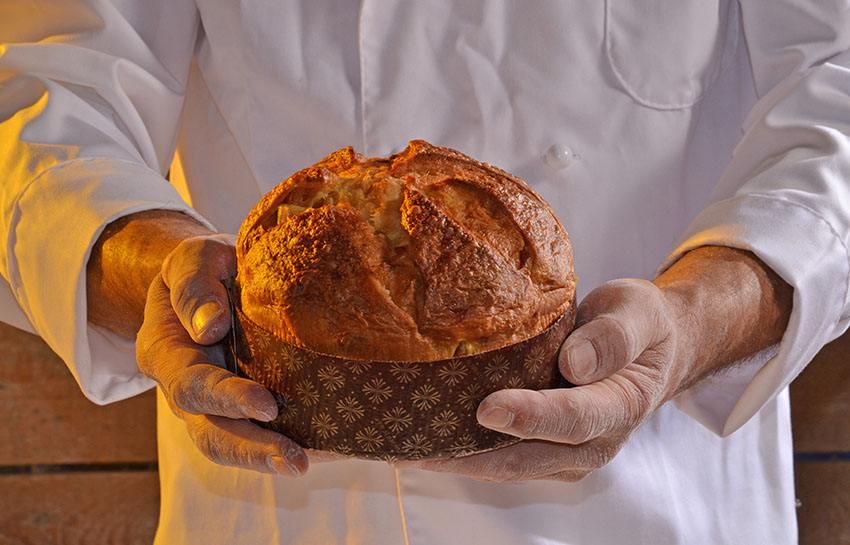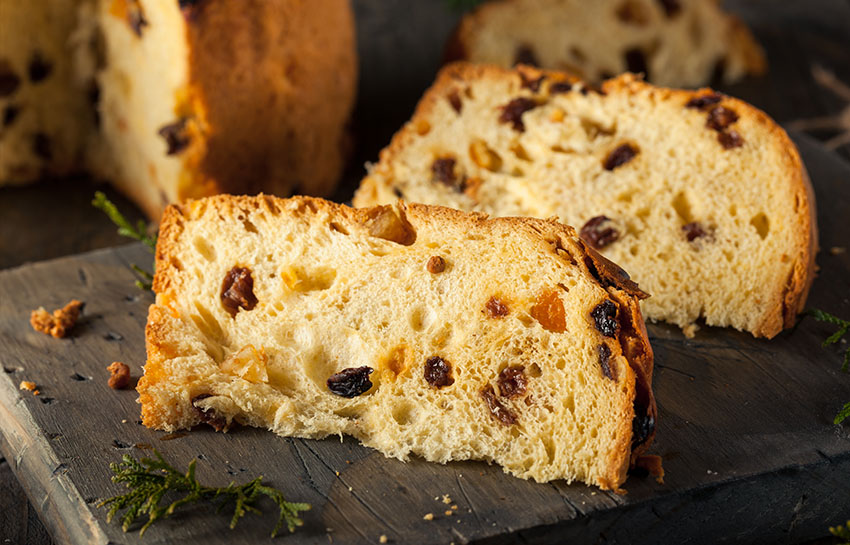
Buttery. Sugary. Citrusy. Sweet. The taste of Panettone transcends time & tradition and bakes both into a delectable dessert. The Italian treat has been a local favorite for centuries, baked and served at every important date and family gathering. The sweet bread has gained massive popularity since it first originated in Italy, eventually ending up on holiday-decorated dining tables worldwide. Over time, as the recipe made its way around the globe, several cultures made modifications and substitutions to its listed ingredients and baking process, forming new variations of the circular bread. However or wherever you enjoy Panettone, it’s bound to be a welcome treat.
The literal definition of Panettone translates to “large cake,” the perfect description. These big delicacies are presented as masterful pieces of art on display in shop windows across Italy during the festive season. While the cake itself doesn’t bear the typical adornment of frosting and sprinkles, it is usually carefully wrapped in an elegant box, with glistening shades of gold, red, blue and silver, all tied together with a delicate ribbon. It is a tradition in Italian households to purchase several Panettone at the beginning of the holiday season to use as gifts for family members, neighbors or last-minute visitors. And, of course, one is saved for the shopper’s dining table, to be sliced and picked at by them and their loved ones.

The origins of the cylindrical bread/cake hybrid remain unknown, although one popular theory suggests it was created in the 15th century by a chef named Toni. Legend says the Duke of Milano, Ludovico il Moro threw a grandiose feast on Christmas Eve for the entirety of his royal court, serving twelve courses, with each course assigned to a specific chef. Toward the end of the night, after having had already enjoyed eleven courses, the time for dessert was imminently approaching. The pastry chef, who had previously been entranced by a nobleman’s beautiful wife, failed to notice his dessert burning in the oven. One young boy on the pastry chef’s team—Toni—went to alert the chef, but once he had realized, it was already too late. The dessert was burned to a crisp. With the serving time approaching and ingredients in short supply by that point in the evening, they had to act fast. All the ingredients that were left in the kitchen pantry were a few scraps of orange peels, some raisins, and leftover dough from the previously burned dessert. Just as the pastry chef was ready to give up, Toni came up with a solution: he mixed up the ingredients left in the kitchen and added dried fruit strategically throughout. He placed the mixture in the oven using a circular pan and created the first Italian Panettone. After presenting the dish to the Duke, he liked it so much he demanded to have it made regularly. The chef said it was Toni’s bread (Pan de Toni), and thus the Panettone was born.

Today, Panettone is not just served on special occasions in Italy but on a casual basis around the globe, enjoyed by people of all ages. Eat it at Sunday dinner, share it with friends or indulge in a slice or two as a midnight snack. But if you’re thinking of making your own cake loaf, patience is a virtue—it’ll be two days before you’ll be able to dig into a piece, although the first bite will be completely worth it. The high amount of effort and labor going into this recipe is part of what makes it stand out on any dessert table. Bringing a homemade Panettone to a friend would earn you endless brownie points and bragging rights for years to come.
Once the Panettone craze began to spread worldwide, several countries started to make their own variations by substituting or adding ingredients, modifying the proofing time and/or changing the baking process. In Russia, they have a similar dessert called Kulich, which is a bit closer to sponge cake and is often served at Easter. In England, chefs make rectangular Christmas Cake, a fruit cake with a blanket of powdered sugar. And bakers in India like to make Allahabadi cake, much like England’s Christmas cake but replacing butter with ghee and adding ginger, nutmeg, fennel seeds and candied white pumpkin.
While interpreted in many different forms, true traditional Italian Panettone ultimately “takes the cake.” There’s nothing quite like sharing Panettone with your loved ones, embracing the deep history and traditions behind it, and making your own life-long memories over a few slices. Enjoy the tastes of classic Italy without having to hop on a plane and bring Flora Fine Foods’ Panettone to your table, where the good times await.